In-Depth Insight into Valvular Heart Disease
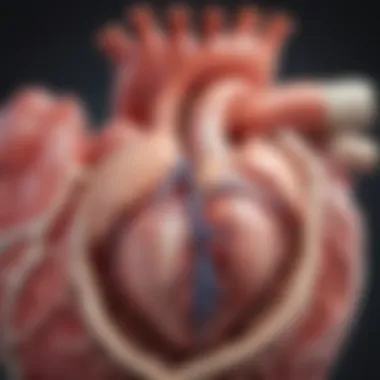
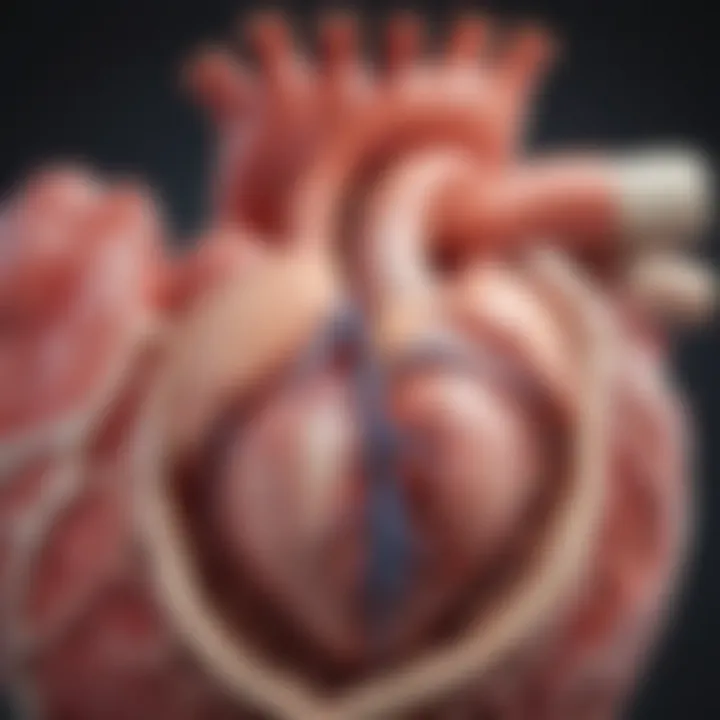
Intro
Valvular heart disease captures the attention of medical professionals and researchers alike due to its profound impact on cardiovascular health. The heart valves, essential for guiding blood flow through the heart, can suffer from various conditions. These issues may lead to severe complications if not understood and treated appropriately. In this article, we will explore the landscape of valvular heart disease, shedding light on its types, the underlying mechanisms, diagnostic methods, and available treatment options. Such insights will enhance our comprehension of this critical area in cardiology.
Recent Advances
Latest Discoveries
Recent research has significantly expanded our knowledge regarding valvular heart diseases, particularly focusing on the underlying pathophysiology. There are discovered genetic factors that may predispose individuals to conditions like aortic stenosis and mitral regurgitation. Studies have shown that molecular changes in valve tissue can also contribute to disease progression. For instance, calcific degeneration of the aortic valve has been linked to inflammatory responses and cellular mechanisms that warrant further investigation.
Another notable advancement is the identification of biomarkers that can predict outcomes for patients with valvular heart diseases. Early detection through biomarker assays can lead to more timely interventions, potentially improving survival rates and quality of life for those affected.
Technological Innovations
Technological progress in imaging techniques has reshaped how valvular heart disease is diagnosed and monitored. Advanced echocardiography, including 3D echocardiography, offers enhanced structural visualization of heart valves. This innovation allows clinicians to assess valve morphology and function with increased precision.
Moreover, the emergence of transcatheter interventions represents a significant breakthrough. Transcatheter aortic valve replacement (TAVR) is now a common procedure for aortic stenosis, providing a less invasive option for patients who are unsuitable for traditional surgery. These advancements demonstrate the evolving approach to managing valvular heart disease, emphasizing the importance of tailoring treatment plans to individual patient needs.
"Understanding the intricacies of valvular heart disease is key to providing effective treatment strategies, ensuring better patient outcomes."
Methodology
Research Design
A comprehensive review of existing literature on valvular heart disease was conducted. This involved analyzing peer-reviewed journals, clinical guidelines, and notable studies that focused on various aspects of the disease.
Data Collection Techniques
Data was collected using various techniques including:
- Systematic reviews of clinical studies
- Meta-analyses to summarize findings
- Observation of patient outcomes in clinical trials
This structured approach ensures that the information presented is up-to-date, relevant, and applicable to clinical practice, enabling healthcare professionals to make informed decisions regarding diagnostics and treatment.
Intro to Valvular Heart Disease
The exploration of this subject allows us to gain insights into the mechanisms behind valve dysfunction and the clinical outcomes associated with it. Early recognition and diagnosis can significantly affect a patient's prognosis. Therefore, a comprehensive understanding of valvular heart disease is vital for effective management and treatment strategies.
Definition and Importance
Valvular heart disease can be defined as any disorder of the heart valves that alters their normal function. This condition encompasses a spectrum of problems, such as stenosis, regurgitation, and prolapse. Each type of disorder leads to distinct pathophysiological changes in the heart, ultimately impacting overall cardiac function.
The importance of addressing valvular heart disease cannot be overstated. As it often presents with insidious symptoms, awareness of its signs is essential for timely intervention. Many individuals may not recognize symptoms such as fatigue or shortness of breath until the condition has progressed. Therefore, thorough education on the definitions and implications of these disorders can promote better health outcomes and empower patients to seek necessary care.
Historical Context
The study and understanding of valvular heart disease have evolved substantially over the decades. Historically, valvular diseases were often attributed to rheumatic fever, primarily affecting children and young adults. The development of effective prevention strategies and treatment options has transformed patient management significantly.
In the mid-20th century, advancements in diagnostic tools, especially echocardiography, revolutionized the way valvular heart diseases were diagnosed and understood. The ability to visualize heart valves in real time has enabled clinicians to make more informed decisions regarding treatment. Furthermore, surgical interventions, such as valve repair and replacement techniques, have developed through years of clinical experience and research, considerably enhancing the quality of life for many patients.
Today, the integration of technology and personalized medicine in managing valvular heart disease continues to improve prognoses and treatment outcomes.
"The evolution of our understanding of valvular heart disease has paved the way for innovations in treatment and improved patient care."
This historical perspective sets the stage for a deeper exploration of the anatomy, types, and management of valvular heart disease.
Anatomy of Heart Valves
Structure and Function of Heart Valves
Heart valves are primarily composed of three key layers: the endothelial layer, the fibrous layer, and the muscular layer. The endothelial layer, or endothelium, provides a smooth surface for blood flow. The fibrous layer maintains the valve's shape and structural integrity, while the muscular layer aids in the valve’s closure.
Each valve operates through a mechanism of opening and closing. This process relies on the pressure differences created within the heart's chambers during the cardiac cycle. As blood is pumped from one chamber to another, valves open to allow passage and close tightly to prevent backflow.
Types of Heart Valves
Heart valves can be categorized into four main types: the aortic valve, mitral valve, pulmonary valve, and tricuspid valve. Each valve plays a unique role in cardiac function.
Aortic Valve
The aortic valve is located between the left ventricle and the aorta. It has three cusps and is crucial in ensuring that oxygenated blood flows from the heart to the rest of the body. A key characteristic of the aortic valve is its ability to withstand high pressure, given that it manages significant volume and pressure during systole. This strength makes it a vital element in maintaining systemic circulation. However, the aortic valve can be prone to both stenosis and regurgitation, which can lead to serious health issues. The monitoring of its function is therefore essential in patients with heart disease.
Mitral Valve
The mitral valve is situated between the left atrium and left ventricle, consisting of two cusps. Its primary function is to allow blood to flow from the atrium to the ventricle while preventing backflow. The unique feature of the mitral valve is its chordae tendineae, which anchor the valve to the heart muscle. This aspect prevents the valve leaflets from prolapsing into the atrium during contraction. Dysfunction can lead to conditions like mitral valve prolapse, which may require surgical intervention in severe cases to restore proper function.
Pulmonary Valve
Positioned between the right ventricle and pulmonary artery, the pulmonary valve consists of three leaflets, similar to the aortic valve. Its main role is to direct deoxygenated blood from the heart to the lungs for oxygenation. A key characteristic is its backflow prevention feature. However, the pulmonary valve does not experience as much pressure compared to the aortic valve. Disorders affecting this valve are less common but can significantly impact overall heart function if they occur.
Tricuspid Valve
The tricuspid valve lies between the right atrium and right ventricle. It typically has three cusps, hence its name. The primary function of the tricuspid valve is to facilitate blood flow from the atrium to the ventricle while preventing regurgitation. A distinctive aspect of the tricuspid valve is its larger size compared to the mitral valve. Its size can be advantageous, especially in accommodating changes in blood volume. However, left untreated, its dysfunction can lead to complications such as congestive heart failure.
In summary, understanding the structure and function of these heart valves is essential. It not only lays the groundwork for comprehending valvular heart diseases but also highlights the complexity of how these components interact to maintain cardiovascular health.
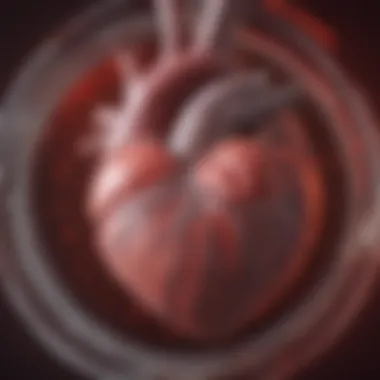
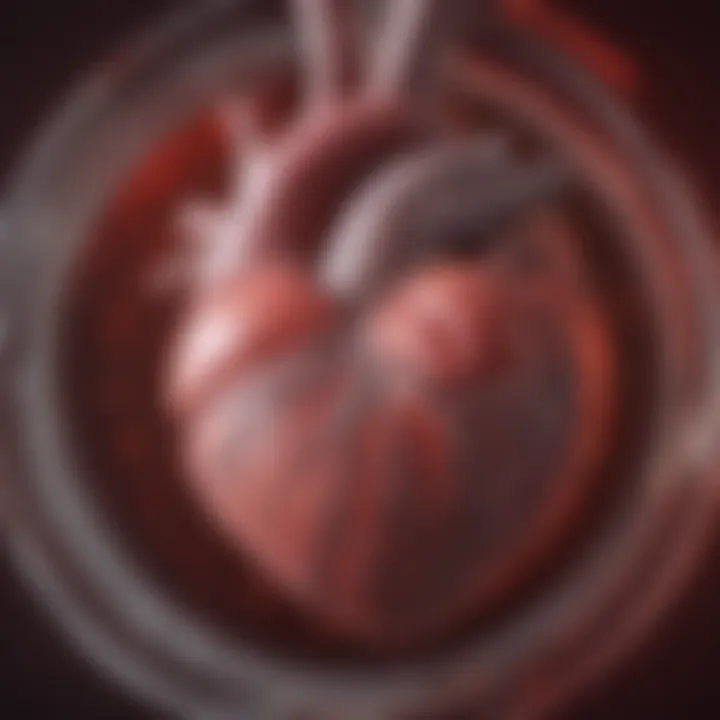
Types of Valvular Heart Disease
Valvular heart disease is fundamental in cardiovascular medicine, impacting millions across the globe. Understanding its types is critical for distortion the implications and treatment objectives. Different forms of this disease present distinct challenges and opportunities for intervention. Recognizing the variety fosters a comprehensive approach to diagnosis and manages care effectively.
Stenosis
Stenosis occurs when a heart valve narrows, limiting blood flow through the heart. This condition can occur in any of the four heart valves: aortic, mitral, pulmonary, and tricuspid. The narrowing can arise due to congenital abnormalities, age-related degeneration, or rheumatic fever. In severe cases, stenosis leads to increased pressure on the heart, as it struggles to pump blood past the narrowed valve. Key symptoms often include fatigue, shortness of breath, and chest pain.
Management often requires monitoring and evaluation via echocardiograms, with surgical options considered when symptoms worsen. Aortic stenosis, in particular, stands out due to its prevalence in older populations, necessitating early detection as it can significantly impact mortality rates.
Regurgitation
Regurgitation represents another form of valvular heart disease, characterized by the backflow of blood due to improper valve closure. This dysfunction can occur in any heart valve and usually results in volume overload on the heart chambers. Symptoms can range from mild to severe, often encompassing palpitations, fatigue, and increased pressure in the lungs.
Understanding the underlying cause is crucial. Possible causes include rheumatic fever, infective endocarditis, or degenerative changes in the valve. Diagnostic approaches focus heavily on echocardiography to assess the volume of regurgitation and the degree of ventricular dilation. Treatment strategies may involve medical management or eventual surgical options, such as valve repair or replacement.
Prolapse
Prolapse, specifically mitral valve prolapse, is characterized by the abnormal displacement of a valve leaflet during systole. It occurs more frequently in women and may be asymptomatic. However, it can lead to regurgitation in some cases. Patients might experience symptoms such as palpitations or chest discomfort, but many remain entirely asymptomatic, complicating effective assessment.
Diagnosing prolapse often involves echocardiography, focusing on the leaflets' motion. While often benign, significant mitral prolapse may require careful monitoring and intervention, particularly if associated with regurgitation or left ventricular dysfunction.
In summary, comprehension of the types of valvular heart disease offers essential insights. From stenosis to regurgitation and prolapse, recognizing these conditions enriches our knowledge and shapes clinical approaches to effectively manage the health implications associated with valvular disorders.
Pathophysiology of Valvular Disorders
Understanding the pathophysiology of valvular disorders is essential for grasping how these conditions affect overall heart function. The interplay of valve anatomy, function, and disease mechanisms portrays the cascade of events that lead to cardiac impairment. Analyzing these factors helps clinicians determine the most appropriate interventions for patients, making this subject pivotal in cardiovascular health.
Mechanisms of Dysfunction
The dysfunction of heart valves can arise through several mechanisms, each characterized by distinct changes. Primarily, dysfunction results from structural alterations in the valves. These structural changes might stem from conditions such as rheumatic fever, degenerative diseases, or infective endocarditis.
The mechanisms can be categorized as:
- Stenosis: This refers to the narrowing of the valve opening, hindering blood flow. Stenosis can occur in any of the four heart valves. Aortic stenosis, for example, leads to increased pressure in the left ventricle as it works harder to pump blood through a narrowed route.
- Regurgitation: In this case, the valve fails to close properly, allowing blood to flow backward. Mitral regurgitation is common, leading to volume overload in the left atrium and eventually affecting systemic circulation.
- Prolapse: This is a specific dysfunction where a valve leaflets bulge into the atrium due to weakness in the supporting structures. A mitral valve prolapse can lead to significant complications, reflecting the need for precise diagnosis and management.
These mechanisms combine to produce hemodynamic changes that directly impact cardiac performance. Recognizing the implications of these dysfunctions is crucial for understanding the overall impact on heart health.
Impact on Cardiac Function
Valvular heart disease significantly compromises cardiac function, leading to various clinical manifestations. The impact takes form through altered hemodynamics, which can result in a range of symptoms and complications.
Effects of valvular dysfunction include:
- Heart Failure: Due to the increased workload from valvular abnormalities, the heart may struggle to maintain efficient circulation, leading to symptoms such as fatigue, dyspnea, and fluid retention.
- Arrhythmias: Structural changes in the heart's chambers and myocardial strain can lead to electrical disturbances, causing arrhythmias. This increased risk can further complicate the clinical picture, necessitating careful monitoring.
- Increased Risk of Stroke: Certain types of valvular disease, particularly regurgitation, can contribute to the formation of thrombi in the heart chambers, raising the risk for cerebrovascular accidents.
Valvular disorders create a cycle of cardiac dysfunction where one problem exacerbates another, emphasizing the complexity of managing these conditions.
Managing the pathophysiology of valvular diseases requires comprehensive approaches. Recognizing the dysfunction mechanisms and their impact on heart performance can lead to better-targeted treatments, ultimately aiming to improve patient outcomes.
Risk Factors and Etiology
Understanding the risk factors and etiology of valvular heart disease is crucial for addressing this significant aspect of cardiovascular health. Knowing the elements that contribute to the development of this disease enables clinicians and researchers to identify at-risk populations and implement preventive measures. Furthermore, a clear grasp of these factors can inform treatment strategies and improve patient outcomes. By exploring both genetic and acquired conditions, we can gain insight into the complex interactions that lead to valvular dysfunction.
Genetic Factors
Genetic factors play an essential role in the development of valvular heart disease. Certain hereditary conditions can predispose individuals to valve abnormalities. For example, conditions such as Marfan syndrome lead to structural changes in connective tissues, which can affect valve integrity. The key characteristic of genetic influence is its often silent yet progressive nature; many patients might not display symptoms until advanced disease stages. This highlights the importance of early genetic screening in families where heart disease is prevalent. Understanding these genetic links provides valuable knowledge for both early intervention and management.
Acquired Conditions
Acquired conditions are significant contributors to valvular heart disease. Various health issues can lead to changes in heart valve function. Three main acquired conditions include:
Rheumatic Fever
Rheumatic fever is an inflammatory disease that can arise after a throat infection with streptococcus bacteria. It predominantly affects children and can cause serious heart damage, particularly involving heart valves. The key characteristic of rheumatic fever is that it frequently develops as a complication from untreated strep throat, making effective treatment of bacterial infections crucial. Rheumatic fever's unique feature is its potential to cause progressive damage to heart valves, leading to conditions like mitral stenosis. This is a beneficial point for this article because it emphasizes the importance of timely treatment of infections and proper follow-up care, which may prevent long-term complications.
Degenerative Changes
Degenerative changes often occur due to aging or other factors and lead to conditions such as aortic stenosis. This gradual wear and tear on the valves can alter their structure and functionality over time. The key characteristic of degenerative changes is their insidious nature; symptoms may not present until significant damage has occurred. This materializes as an important topic here because it raises awareness about regular heart monitoring, especially in elderly populations. Early identification of degenerative changes can lead to timely interventions, improving patient quality of life.
Infective Endocarditis
Infective endocarditis is an infection of the inner lining of the heart chambers and valves. It often occurs when bacteria enter the bloodstream and attach to damaged areas of the heart. Key characteristics include its rapid onset and potential for severe complications. The role of infective endocarditis in valvular heart disease is significant as it can lead to valve destruction and heart failure if not addressed swiftly. Highlighting this condition in the article is essential because it underscores the importance of maintaining good dental hygiene and treating infections promptly. Understanding its acute nature informs both preventive and therapeutic strategies that can drastically affect patients' lives.
"Understanding the factors that lead to valvular heart disease is key in preventing and managing this serious health issue."
In summary, the exploration of both genetic and acquired risk factors highlights vital areas of focus for clinicians and patients alike. Awareness of these factors can lead to better prevention, timely diagnosis, and intervention, ultimately improving health outcomes in valvular heart disease.
Clinical Presentation
The clinical presentation of valvular heart disease is a crucial aspect of understanding this condition. It provides insight into how the disease manifests in patients and highlights the importance of recognizing symptoms early. An accurate clinical presentation leads to better management of the disease and potentially improved outcomes for patients. Recognizing the signs can facilitate timely interventions and tailored treatment approaches.
Symptoms
Symptoms associated with valvular heart disease vary widely and depend on several factors. These include the type of valvular defect, the severity of the condition, and individual patient factors. Common symptoms may include:
- Shortness of breath: This may occur during exertion or even at rest as the heart struggles to pump effectively.
- Fatigue: A constant feeling of tiredness can signify reduced cardiac output.
- Palpitations: Patients may experience irregular heartbeats or a sensation of their heart racing.
- Chest pain: Discomfort or pain in the chest can occur due to reduced blood flow or increased workload on the heart.
- Swelling: Edema in the legs, ankles, or abdomen can result from heart failure or fluid buildup.
- Dizziness or fainting: Reduced blood flow to the brain can lead to these symptoms, particularly during exertion.
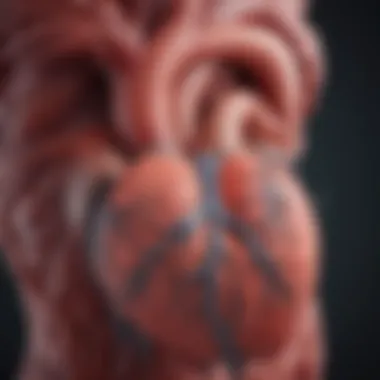
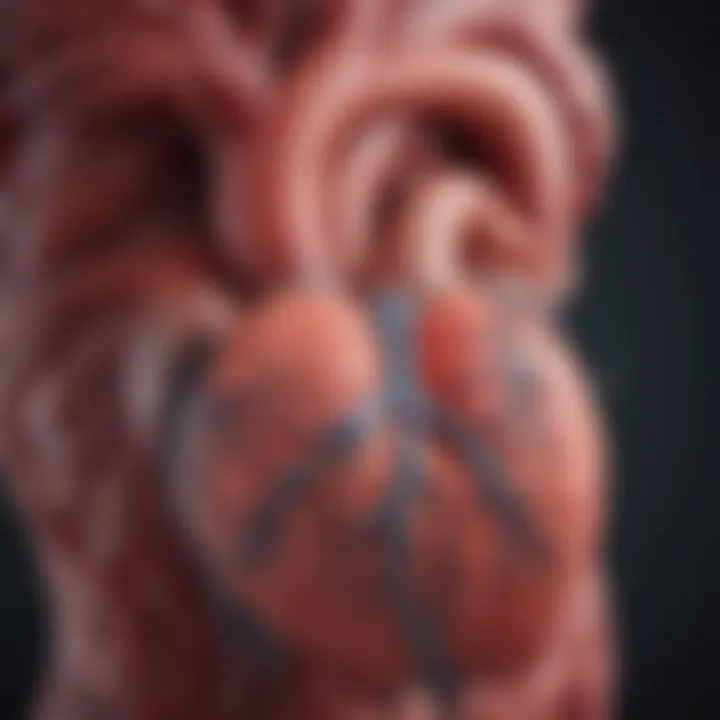
It's important to understand that these symptoms can be subtle and often misattributed to other conditions. Awareness of this can ensure better monitoring and diagnosis.
Physical Examination Findings
Physical examination plays a vital role in the evaluation of valvular heart disease. A physician's assessment can reveal key findings that suggest potential valvular dysfunction. Key examination findings may include:
- Heart sounds: Abnormal heart sounds, such as murmurs, can indicate turbulent blood flow due to stenosis or regurgitation.
- Blood pressure measurements: Variations from normal blood pressure can reflect the heart's workload and efficiency.
- Signs of heart failure: Observable swelling (edema), jugular venous distention, and pulmonary crackles may indicate underlying heart dysfunction.
Detailed examination findings contribute significantly to the diagnostic process. They can guide the need for further investigations or monitoring.
The early detection of symptoms and findings is imperative in managing valvular heart disease effectively. Prompt intervention can make a distinct difference in patient outcomes.
Overall, understanding the clinical presentation of valvular heart disease offers valuable insight into the condition, aiding healthcare practitioners and patients alike in addressing this complex health issue.
Diagnostic Approaches
In the realm of valvular heart disease, accurate diagnosis is paramount. Diagnostic approaches aid in identifying the specific type of valvular dysfunction present, its severity, and the resultant impact on cardiac function. Timely and precise diagnosis not only informs treatment strategies but also guides the prognosis for affected individuals. By leveraging various diagnostic tools, healthcare professionals can make informed decisions that significantly influence patient outcomes.
Echocardiography
Echocardiography serves as a cornerstone in the diagnostic evaluation of valvular heart disease. Utilizing high-frequency sound waves, it produces real-time images of the heart's structure and function. This non-invasive technique enables clinicians to assess valve morphology, measure flow dynamics, and estimate pressure gradients across heart valves.
The different modalities within echocardiography — such as transthoracic echocardiography (TTE) and transesophageal echocardiography (TEE) — each offer unique benefits. TTE is often the first-line assessment due to its convenience and ease of use. On the other hand, TEE provides more detailed images and is particularly useful in cases where TTE results are inconclusive.
This testing allows for:
- Evaluation of valvular structure: Identifies deformities like calcification or prolapse.
- Assessment of blood flow: Determines severity of stenosis or regurgitation through Doppler measurements.
- Detection of accompanying conditions: Analyzes left ventricular function and identifies possible thrombi.
In summary, echocardiography is crucial in forming a comprehensive picture of valvular heart disease, guiding subsequent therapeutic decisions.
Electrocardiogram (ECG)
The ECG provides essential information about the heart's electrical activity and rhythm. In patients suspected of having valvular heart disease, this test can reveal important clues about underlying cardiac issues. Changes in the ECG may suggest left atrial enlargement, left ventricular hypertrophy, or arrhythmias, which can be secondary to valvular abnormalities.
A comprehensive ECG may present:
- Increased voltage: Indicative of left ventricular hypertrophy in cases of aortic stenosis.
- Atrial fibrillation: Commonly associated with mitral valve disease, leading to increased risk of embolic events.
- Conduction delays: Can reflect the presence and severity of structural heart changes.
By integrating ECG findings with clinical assessment and echocardiography results, healthcare professionals can more effectively diagnose valvular heart disease and tailor treatment approaches accordingly.
Cardiac Catheterization
Cardiac catheterization offers a direct method for assessing valvular heart disease, particularly in complex cases. This invasive technique involves threading a thin catheter through blood vessels to the heart, allowing for precise measurement of pressures and blood flow dynamics.
One of the significant benefits of cardiac catheterization is its capacity to provide data on:
- Hemodynamic measurements: Enables evaluation of pressure gradients across valves, essential for diagnosing severe stenosis.
- Direct visualization of coronary arteries: Important for patients with valvular disease and concurrent coronary artery disease.
- Assessment of treatment response: Post-intervention evaluation can be done through repeat catheterization to examine improvements in valve function.
However, it is essential to note that cardiac catheterization necessitates careful consideration due to its risks, including bleeding, infection, or adverse reactions to contrast dye. It often follows non-invasive testing like echocardiography when more detailed investigation is warranted.
Understanding various diagnostic approaches is vital in managing valvular heart disease effectively. Each tool offers distinct advantages and is part of a multi-faceted assessment strategy that ensures optimal patient care.
Management Strategies
Management strategies for valvular heart disease are critical for enhancing patient outcomes. Proper management not only alleviates symptoms but also addresses the underlying problems associated with various valve disorders. In this section, we will explore the two primary management approaches: medical treatment and surgical intervention. Each plays a distinct role in managing valvular heart disease and may be indicated depending on the severity and type of valve dysfunction.
Medical Treatment
Medical treatment encompasses a variety of approaches designed to manage symptoms and improve quality of life in patients with valvular heart disease.
Pharmacological Approaches
Pharmacological approaches serve as a cornerstone in the management of valvular heart diseases. Medications can mitigate symptoms, prevent complications, and improve the overall function of the heart.
One key characteristic of pharmacological approaches is their ability to manage symptoms without invasive procedures. Common medications include diuretics, beta-blockers, and anticoagulants, depending on the underlying condition of the patient. For instance, diuretics can help reduce fluid overload in cases of heart failure due to regurgitant valves.
Pharmacological management allows for symptomatic relief while providing a non-invasive means to treat valvular heart disease.
The unique feature of pharmacological treatment is its flexibility. Physicians can adjust dosages based on patient response, which is beneficial for personalizing treatment. However, there are disadvantages as well, such as potential side effects and the need for ongoing monitoring. Careful selection of medications is crucial for ensuring patient safety and optimizing outcomes.
Lifestyle Modifications
Lifestyle modifications play an essential role in the overall management of valvular heart disease. They help improve cardiovascular health and can be crucial complements to medical treatments.
A key characteristic of lifestyle modifications is their accessibility. Patients can enact changes that lead to better health outcomes without need for prescription medications. Common recommendations include dietary changes, regular physical activity, and smoking cessation. For example, a heart-healthy diet low in saturated fats can reduce the burden on the heart.
The unique feature of lifestyle modifications is their preventive nature. By adopting healthier habits, patients may delay the progression of valve disease. However, adherence can be challenging, and the effectiveness of these modifications often relies on patient motivation and education.
Surgical Intervention
In cases where medical treatment is insufficient, surgical intervention becomes a necessary option. This approach is crucial for correcting structural valve problems.
Valve Repair
Valve repair is a surgical procedure aimed at restoring proper function to damaged heart valves. Its primary contribution to the overall management of valvular heart disease lies in its ability to maintain the patient’s own valve while correcting dysfunction. This results in lower complication rates compared to replacing the valve entirely.
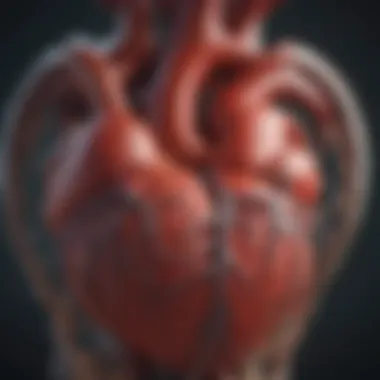
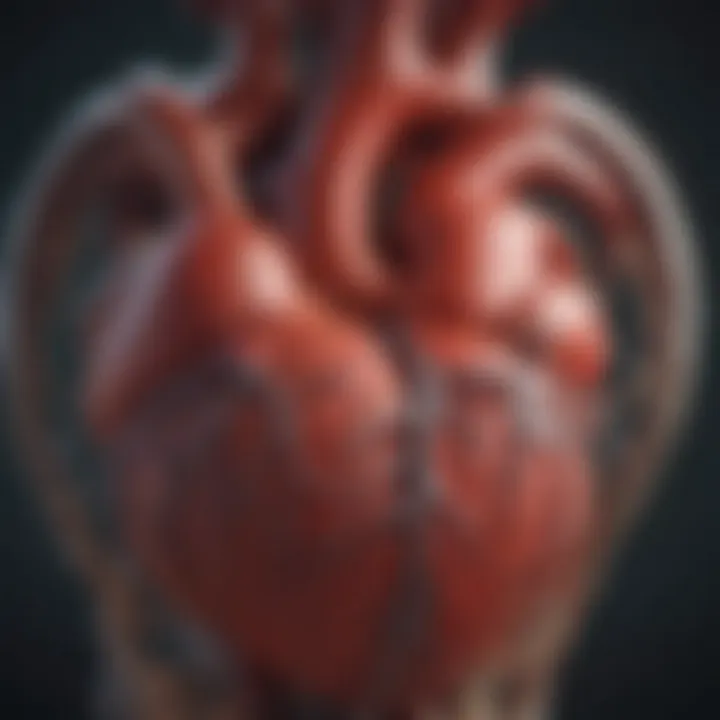
A significant characteristic of valve repair is its focus on preserving the anatomical structure of the heart. Surgical options may include commissurotomy and annuloplasty, depending on the specific valve issues. The unique feature of valve repair is that it often results in better postoperative heart function, as the natural valve remains intact.
However, valve repair can be technically demanding and may not be suitable for all patients, which is a limitation to consider when forming a management plan.
Valve Replacement
Valve replacement is often indicated in severe cases where repair is not feasible. This procedure involves removing the diseased valve and substituting it with either a mechanical or biological valve. The contribution of valve replacement to managing valvular heart disease is significant, especially in patients with serious symptoms or heart failure.
A key characteristic of valve replacement is its effectiveness in restoring normal function to the heart. This can lead to dramatic improvements in quality of life for patients experiencing debilitating symptoms. The unique feature of valve replacement is the availability of different types of valves, which allows for tailored patient options based on lifestyle and medical needs.
However, there are inherent risks, such as complications from surgery and the need for lifelong anticoagulation therapy with mechanical valves.
By understanding all management strategies, healthcare providers and patients can collaborate closely to select the most appropriate approach, improving the overall treatment of valvular heart disease.
Prognosis and Outcome
The prognosis and outcome of valvular heart disease are critical topics that warrant careful examination. Understanding the implications of this disease can significantly aid in guiding treatment options and improving patient care. A proper prognosis allows healthcare professionals to create tailored management strategies that align with individual patient needs, and thus, can enhance overall survival and quality of life. Prognosis is influenced by various factors unique to valvular heart disease, such as the specific type of valve affected, the severity of the condition, co-existing health issues, and the timing of intervention.
Factors Influencing Prognosis
There are several key factors that can influence the prognosis of patients diagnosed with valvular heart disease. These can be categorized into:
- Type of Valvular Disease: Different types of valvular heart diseases, such as stenosis or regurgitation, may have varying outcomes. For example, severe mitral regurgitation typically necessitates surgical intervention sooner to improve prognosis.
- Severity of the Disease: The degree of valve dysfunction plays a significant role in determining the prognosis. For instance, asymptomatic patients with mild valve disease often have a better outcome compared to symptomatic patients with severe disease.
- Ejection Fraction: A key indicator of heart function, the left ventricular ejection fraction can significantly impact survival. Lower ejection fractions often correlate with worse outcomes.
- Comorbidities: The presence of other medical conditions, such as diabetes, hypertension, or coronary artery disease, can complicate the clinical picture, making management and prognosis more challenging.
- Age: Older patients tend to have a different disease trajectory. Age-related factors can influence both response to treatment and overall survival rates.
It is important for clinicians to evaluate these factors holistically for a comprehensive view of the patient’s prognosis.
Long-term Outcomes
Long-term outcomes for patients with valvular heart disease vary widely but can be significantly improved with timely and appropriate intervention. Data indicates that patients who undergo surgical procedures like valve repair or replacement generally report favorable outcomes, particularly when performed before the onset of severe symptoms or irreversible heart damage.
- Surgical Outcomes: Many studies indicate that surgical intervention can lead to increased longevity and significantly reduced symptom burden. Patients often experience an enhancement in the quality of life post-surgery.
- Survival Rates: Studies show that 5 to 10-year survival rates can be higher than 80% in individuals who receive timely surgical correction for severe valve disease. Those untreated may see a proactive decline where survival rates decline considerably due to progressive heart failure.
- Cardiac Rehabilitation: Engaging in cardiac rehabilitation programs post-surgery has also shown to positively affect long-term outcomes. These programs help to educate patients about lifestyle modifications and facilitate a smoother recovery.
While advancements in surgical techniques contribute positively to outcomes, ongoing research continues to explore the long-term effects of novel therapies, including transcatheter approaches for those not suited for traditional surgery.
Emerging Research and Innovations
Emerging research and innovations in valvular heart disease are essential for advancing our understanding of these conditions and improving patient care. As the field evolves, scientists and clinicians are developing new therapeutic strategies and diagnostic tools aimed at enhancing outcomes. These innovations offer the promise of more precise, effective treatments and the potential for tailored management of valvular disorders.
Novel Therapeutics
Recent developments in novel therapeutics have significantly broadened the scope of treatment options available for patients with valvular heart disease. Advances in pharmacotherapy focus on addressing the underlying mechanisms of valvular dysfunction. For example, new medications aim to reduce inflammation and improve heart function, targeting the pathophysiological changes associated with these diseases.
Additionally, innovative approaches such as tissue engineering and regenerative medicine are being explored. These techniques involve using biological scaffolds and stem cells to repair or replace damaged heart valves. This could minimize the need for traditional surgical interventions, potentially leading to quicker recovery times and better overall outcomes for patients.
Technological Advancements in Diagnosis and Treatment
Technological advancements play a vital role in enhancing the diagnosis and treatment of valvular heart disease. Imaging techniques have evolved significantly, improving the accuracy of assessments. For instance, the use of three-dimensional echocardiography provides detailed anatomical information, allowing for better evaluation of valve structure and function.
Moreover, cardiac MRI and CT scans are becoming increasingly important in the diagnostic process. These modalities can identify complications such as vegetations or annular calcification, crucial in determining the appropriate treatment strategy.
Furthermore, advancements in minimally invasive surgical techniques have improved surgical outcomes. Procedures such as transcatheter aortic valve replacement (TAVR) and percutaneous Mitral Valve Repair have transformed the treatment landscape, offering alternatives to open-heart surgery. By utilizing advanced imaging and robotic-assisted technology, clinicians can achieve precise results while minimizing recovery time for patients.
Innovations in both therapeutics and diagnostics are paving the way for better management of valvular heart disease.
Patient Education and Support
Patient education and support are pivotal aspects when addressing valvular heart disease. Understanding the condition allows patients to participate actively in their treatment and management decisions. This engagement not just improves health outcomes but also enhances patient satisfaction. An informed patient can identify critical symptoms, understand their treatment options, and make lifestyle changes crucial for their wellbeing.
Importance of Patient Awareness
Raising awareness about valvular heart disease among patients can lead to earlier diagnosis and treatment. Patients who understand the disease’s signs, symptoms, and potential complications are more likely to seek medical help when necessary.
- Recognition of Symptoms: Early recognition can prevent progression to severe conditions, reducing hospitalizations.
- Informed Decision-Making: Awareness empowers patients to make educated choices regarding their care options. This is especially meaningful when considering surgical interventions or lifestyle adjustments.
- Compliance with Treatment: Knowledge encourages adherence to prescribed treatments and follow-up schedules, improving overall management of their heart condition.
Resources for Patients
Numerous resources are available to assist patients dealing with valvular heart disease. Organizations develop informative material to guide patients and families. These resources may include:
- Support Groups: Connecting patients with others facing similar challenges fosters emotional support.
- Educational Websites: Reliable online platforms offer up-to-date information on research, treatment options, and lifestyle tips. Websites such as Wikipedia, Britannica provide general knowledge on heart diseases.
- Books and Publications: Educational pamphlets and books can offer detailed insights into valvular heart disease.
- Healthcare Provider Consultation: Regular discussions with cardiologists ensure patients receive tailored advice about their unique conditions.
"Well-informed patients are more likely to engage in health-promoting behaviors and comply with treatment regimens."
Accessing these resources enhances patients' knowledge, resulting in improved management of their heart health and overall quality of life. This emphasis on education is crucial for navigating the complexities associated with valvular heart disease.
Epilogue
An important element to highlight is the need for early detection and effective management strategies. The summary of key points discussed in this article illustrates the various aspects of valvular disease, including types, risk factors, diagnosis, and management. By synthesizing this information, readers gain a comprehensive understanding that is vital for both clinical practice and research.
Moreover, future directions in valvular heart disease research hold promise for better treatment options and improved patient outcomes. Innovations in technology and therapeutics are paving the way for advancements that may transform how these conditions are managed. By staying informed about ongoing research and emerging strategies, healthcare professionals can contribute to enhancing patient care and outcomes.
In summary, the insights provided in evaluating valvular heart disease not only stress its immediate implications but also emphasize ongoing research needs. This adds to the overall importance of the topic and encourages a proactive approach to education and awareness for all stakeholders involved in cardiovascular health.
Summary of Key Points
- Valvular heart disease consists of various conditions that affect heart valve function.
- Early diagnosis is vital for effective management and improved prognosis.
- Several risk factors, both genetic and acquired, contribute to the development of valvular disorders.
- Management strategies include medical treatment and surgical intervention, depending on the severity.
- Ongoing research aims to improve therapeutic options and diagnostic techniques.
Future Directions in Valvular Heart Disease Research
Research is increasingly focusing on:
- Novel therapeutics that target specific mechanisms of valve dysfunction, aiming for more effective treatments.
- Technological advancements in diagnostic processes, such as improved echocardiography techniques and biomarkers for early detection.
- Longitudinal studies to better understand the long-term effects of various interventions on patient outcomes.
Continuing to explore these directions will ultimately lead to better management and understanding of valvular heart disease.















